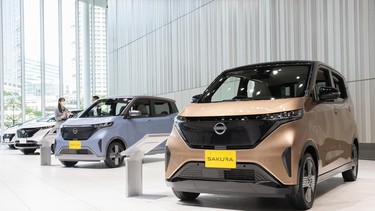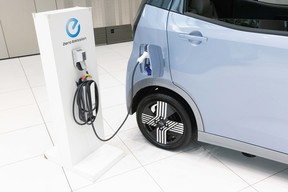The two Japanese automakers understand bigger isn’t always better, especially for the environment — and our wallets

Article content
Here in North America, the most popular vehicles are, love ‘em or leave ‘em, pickups. Big pickups. The bigger the better, in fact. So much so that Ford had to introduce the Ranger to service the market the F-150 left behind in its now decades-long growth spurt; and then, more recently, introduce the Maverick to fill the hole the Ranger left behind in its move upscale. Like I said, we of the Great White Frozen North love us some big-ass trucks.
Article content
Compare that to the Japanese market. While people there are perfectly happy to supply us with the monstrosities we demand — everything from their ever-growing pickups; to Corollas that are the size Camrys used to be — back home, 40 per cent of all car sales are “kei” cars, tiny little city runabouts limited to 63 horsepower and a maximum of 3,400 millimetres of overall length. They are as tiny as a Ford F-450 is huge.
And, like the burgeoning North American market for electric pickups, kei cars are becoming increasingly electrified. For instance, Mitsubishi and Nissan — two-thirds of the Nissan-Renault-Mitsubishi Alliance — just released their latest kei EVs, the Sakura (Nissan) and the oddly-named eK X (Mitsubishi).
Article content
-
![Nissan considering all-electric compact pickup truck: report]()
Nissan considering all-electric compact pickup truck: report
-
![Motor Mouth: Why are Europeans buying more EVs than North Americans?]()
Motor Mouth: Why are Europeans buying more EVs than North Americans?
And, if ever any single automotive specification encapsulated everything that makes the North American automobile market different from all others in the world, it is this: While GMC boasts its Hummer EV’s 200-plus-kilowatt-hour Ultium battery as its primary selling feature, in Japan, the fact the Sakura and the eK X need only 20 kWh to go about their business points to the striking difference between how we and the rest of the world differ in reducing our automotive footprints.
What makes kei cars amazing, however, is that despite the specs listed above, they are far from playtoys. For instance, both Nissan and Mitsubishi claim 180 kilometres of range for their tiny little minivans. They also have perfectly comfortable seating for four, and there’s even room for a modicum of luggage with all four seats occupied.
Article content

Better yet, the EV keis are actually quite a bit sportier than their gasoline equivalents. You see, while horsepower is limited to 63 hp (actually 47 kilowatts) and 660 cc to legally fit into the segment, there’s no restriction on maximum torque, which, if you follow EVs at all, you know is one of the prime benefits of electrification. Thus do both the Sakura and the eK X boast an impressive 144 pound-feet of torque. By way of comparison, the 2022 Sentra Nissan sells here in Canada ekes out just two more lb.-ft. from its 2.0L DOHC four, and it weighs 1,349 kilograms. The Sakura weighs just 1,080 kilograms, which means that, although, it is limited to 130 kilometres an hour, it’s pretty peppy in getting there.
The other big difference between Japanese and North American EVs is, as you might expect, pricing. While even entry-level EVs here in Canada typically command $60,000 — and more! — before incentives and taxes, the base Sakura rings in at 2,333,100 yen, which works out to about CDN$23,400 at current exchange rates, and, according to Reuters, once you factor in local EV incentives, you can drive a battery-powered Nissan for as little as CDN$17,880. The slightly more upscale Mitsu version, meanwhile, will set you back CDN$18,580 after incentives. And I’ll remind you once again that both sit four adults.
Maybe we need to rethink this “bigger is better” thing.
Stay connected with us on social media platform for instant update click here to join our Twitter, & Facebook
We are now on Telegram. Click here to join our channel (@TechiUpdate) and stay updated with the latest Technology headlines.
For all the latest Automobiles News Click Here


